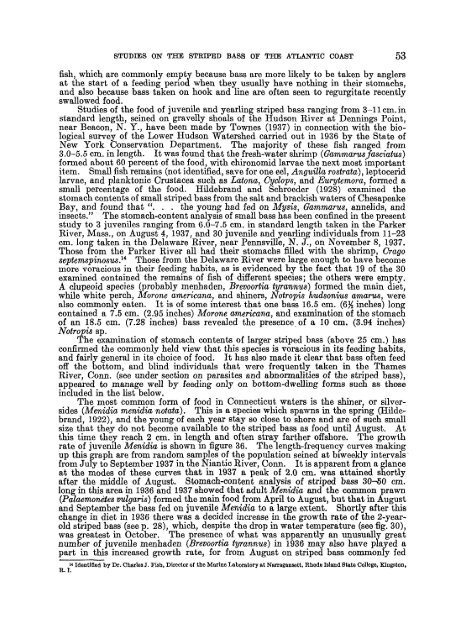Fishery bulletin of the Fish and Wildlife Service - NOAA
Fishery bulletin of the Fish and Wildlife Service - NOAA
Fishery bulletin of the Fish and Wildlife Service - NOAA
Create successful ePaper yourself
Turn your PDF publications into a flip-book with our unique Google optimized e-Paper software.
STUDIES ON THE STRIPED BASS OF THE ATLANTIC COAST 53<br />
fish, which are commonly empty because bass are more likely to be taken by anglers<br />
at <strong>the</strong> start <strong>of</strong> a feeding period when <strong>the</strong>y usually have nothing in <strong>the</strong>ir stomachs,<br />
<strong>and</strong> also because bass taken on hook <strong>and</strong> line are <strong>of</strong>ten seen to regurgitate recently<br />
swallowed food.<br />
Studies <strong>of</strong> <strong>the</strong> food <strong>of</strong> juvenile <strong>and</strong> yearling striped bass ranging from 3-11cm. in<br />
st<strong>and</strong>ard length, seined on gravelly shoals <strong>of</strong> <strong>the</strong> Hudson River at Dennings Point,<br />
near Beacon, N. Y., have been made by Townes (1937) in connection with <strong>the</strong> biological<br />
survey <strong>of</strong> <strong>the</strong> Lower Hudson Watershed carried out in 1936 by <strong>the</strong> State <strong>of</strong><br />
New York Conservation Department. The majority <strong>of</strong> <strong>the</strong>se fish ranged from<br />
3.0-5.5 cm. in length. It was found that <strong>the</strong> fresh-water shrimp (Gammarusfasciatus)<br />
formed about 60 percent <strong>of</strong> <strong>the</strong> food, with chironomid larvae <strong>the</strong> next most important<br />
item. Small fish remains (not identified, save for one eel, Anguilla rostrata), leptocerid<br />
larvae, <strong>and</strong> planktonic Crustacea such as Latona, Cyclops, <strong>and</strong> Eurytemora, formed a<br />
small percentage <strong>of</strong> <strong>the</strong> food. Hildebr<strong>and</strong> <strong>and</strong> Schroeder (1928) examined <strong>the</strong><br />
stomach contents <strong>of</strong> small striped bass from <strong>the</strong> salt <strong>and</strong> brackish waters <strong>of</strong> Chesapeake<br />
Bay, <strong>and</strong> found that ". . . <strong>the</strong> young had fed on Mysis, Gammarus, annelids, <strong>and</strong><br />
insects." The stomach-content analysis <strong>of</strong> small bass has been confined in <strong>the</strong> present<br />
study to 3 juveniles ranging from 6.0-7.5 cm. in st<strong>and</strong>ard length taken in <strong>the</strong> Parker<br />
River, Mass., on August 4, 1937, <strong>and</strong> 30 juvenile <strong>and</strong> yearling individuals from 11-23<br />
cm. long taken in <strong>the</strong> Delaware River, near Pennsville, N. J., on November 8, 1937.<br />
Those from <strong>the</strong> Parker River all had <strong>the</strong>ir stomachs filled with <strong>the</strong> shrimp, Crago<br />
septemspinosus. Those from <strong>the</strong> Delaware River were large enough to have become<br />
more voracious in <strong>the</strong>ir feeding habits, as is evidenced by <strong>the</strong> fact that 19 <strong>of</strong> <strong>the</strong> 30<br />
examined contained <strong>the</strong> remains <strong>of</strong> fish <strong>of</strong> different species; <strong>the</strong> o<strong>the</strong>rs were empty.<br />
A clupeoid species (probably menhaden, Brevoortw, tyrannus) formed <strong>the</strong> main diet,<br />
while white perch, Morone americana, <strong>and</strong> shiners, Notropis hvdsonius amarus, were<br />
also commonly eaten. It is <strong>of</strong> some interest that one bass 16.5 cm. (6X inches) long<br />
contained a 7.5 cm. (2.95 inches) Morone americana, <strong>and</strong> examination <strong>of</strong> <strong>the</strong> stomach<br />
<strong>of</strong> an 18.5 cm. (7.28 inches) bass revealed <strong>the</strong> presence <strong>of</strong> a 10 cm. (3.94 inches)<br />
Notropis sp.<br />
The examination <strong>of</strong> stomach contents <strong>of</strong> larger striped bass (above 25 cm.) has<br />
confirmed <strong>the</strong> commonly held view that this species is voracious in its feeding habits,<br />
<strong>and</strong> fairly general in its choice <strong>of</strong> food. It has also made it clear that bass <strong>of</strong>ten feed<br />
<strong>of</strong>f <strong>the</strong> bottom, <strong>and</strong> blind individuals that were frequently taken in <strong>the</strong> Thames<br />
River, Conn, (see under section on parasites <strong>and</strong> abnormalities <strong>of</strong> <strong>the</strong> striped bass),<br />
appeared to manage well by feeding only on bottom-dwelling forms such as those<br />
included in <strong>the</strong> list below.<br />
The most common form <strong>of</strong> food in Connecticut waters is <strong>the</strong> shiner, or silversides<br />
(Menidia menidia notata). This is a species which spawns in <strong>the</strong> spring (Hildebr<strong>and</strong>,<br />
1922), <strong>and</strong> <strong>the</strong> young <strong>of</strong> each year stay so close to shore <strong>and</strong> are <strong>of</strong> such small<br />
size that <strong>the</strong>y do not become available to <strong>the</strong> striped bass as food until August. At<br />
this time <strong>the</strong>y reach 2 cm. in length <strong>and</strong> <strong>of</strong>ten stray far<strong>the</strong>r <strong>of</strong>fshore. The growth<br />
rate <strong>of</strong> juvenile Menidia is shown in figure 36. The length-frequency curves making<br />
up this graph are from r<strong>and</strong>om samples <strong>of</strong> <strong>the</strong> population seined at biweekly intervals<br />
from July to September 1937 in <strong>the</strong> Niantic River, Conn. It is apparent from a glance<br />
at <strong>the</strong> modes <strong>of</strong> <strong>the</strong>se curves that in 1937 a peak <strong>of</strong> 2.0 cm. was attained shortly<br />
after <strong>the</strong> middle <strong>of</strong> August. Stomach-content analysis <strong>of</strong> striped bass 30450 cm.<br />
long in this area hi 1936 <strong>and</strong> 1937 showed that adult Menidia <strong>and</strong> <strong>the</strong> common prawn<br />
(Palaemonetes vulgaris) formed <strong>the</strong> mam food from April to August, but that in August<br />
<strong>and</strong> September <strong>the</strong> bass fed on juvenile Menidia to a large extent. Shortly after this<br />
change in diet in 1936 <strong>the</strong>re was a decided increase hi <strong>the</strong> growth rate <strong>of</strong> <strong>the</strong> 2-yearold<br />
striped bass (see p. 28), which, despite <strong>the</strong> drop in water temperature (see fig. 30),<br />
was greatest in October. The presence <strong>of</strong> what was apparently an unusually great<br />
number <strong>of</strong> juvenile menhaden (Brevoortia tyrannus) hi 1936 may also have played a<br />
part in this increased growth rate, for from August on striped bass commonly fed<br />
» Identified by Dr. Charles J. <strong>Fish</strong>, Director <strong>of</strong> <strong>the</strong> Marine Laboratory at Narragansett, Rhode Isl<strong>and</strong> State College, Kingston,<br />
K.I.

















